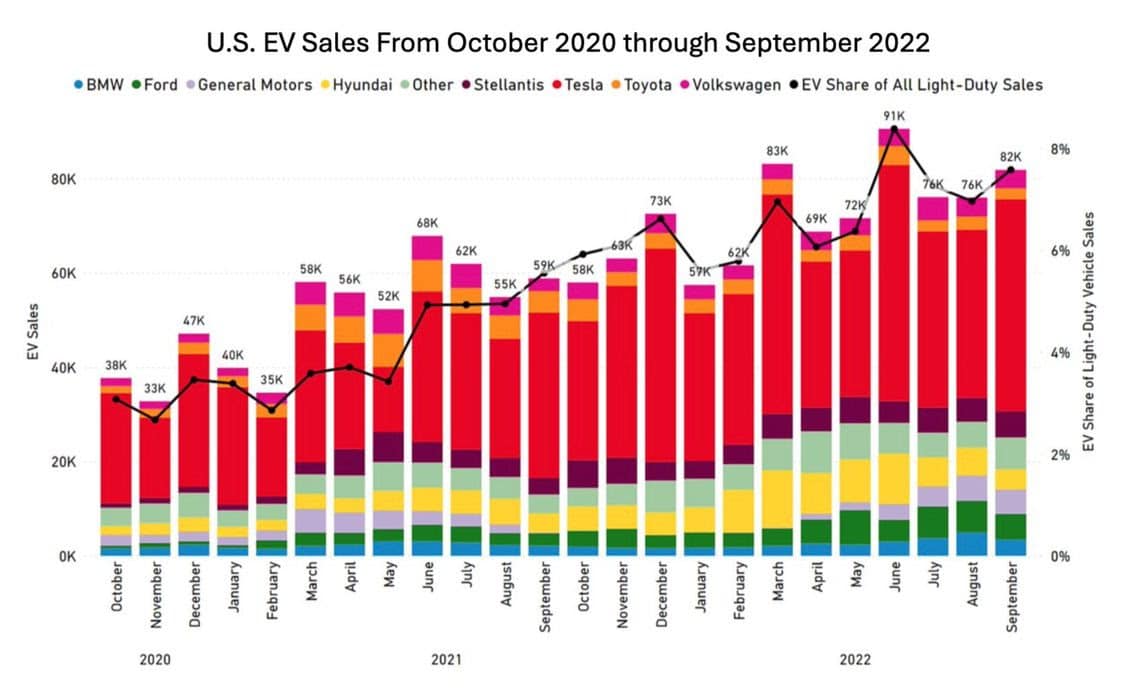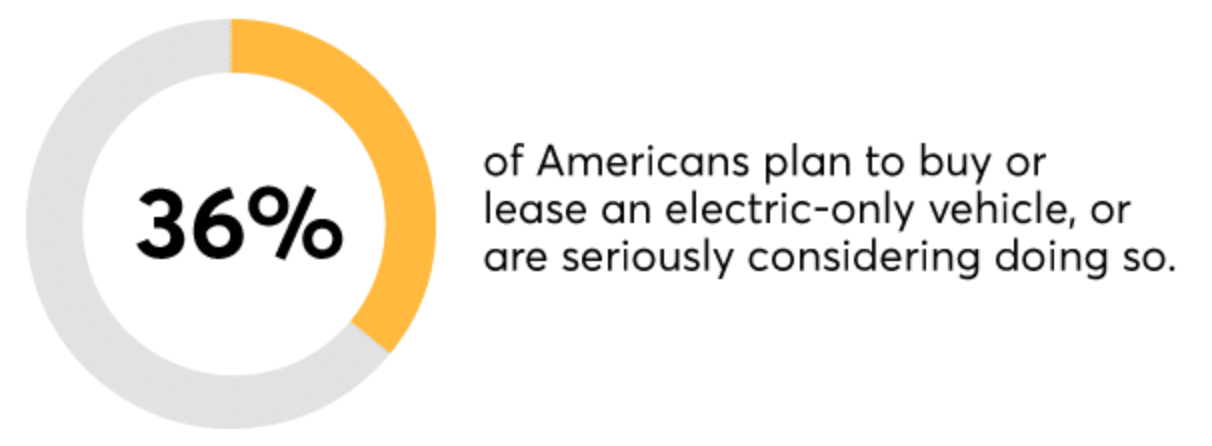During the third quarter of 2022, EV market share hit several key milestones. Today, 14% of vehicle buyers are definitely buying an EV for their next car, with 22% seriously considering it.
Stan Cross | December 7, 2022 | Clean Transportation, Electric VehiclesIndustry analysts have speculated about the imminent rise of electric vehicles for the past decade. Meanwhile, automakers slow-walked the technology and consumers kept buying their gas cars, trucks, and SUVs. So if you stopped paying attention to the EV hype, I don’t blame you.
But you might want to pay attention now, because 2022 will likely mark the year when the EV market lifts off.
EV sales rose 37% in the third quarter of 2022 compared to the same period in 2021. At the same time, EV market share, the percentage of new car sales that are EVs, topped 7%. This is meaningful because once new disruptive technology gets and stays above 5% market share, exponential adoption typically ensues.

This record-setting pace is being spurred by auto industry activities and federal public policies conspiring to knock down the three primary barriers to EV adoption:
- Consumer knowledge and experience
- Vehicle cost
- Charging station access and range anxiety
High gas prices at the pump generate interest in EVs and drive up savings for EV owners who charge their batteries with cheaper, price-stable electricity (I’m on track to save over $2,000 this year driving my Chevy Bolt EV). High gas prices have fueled EV purchases this year, but consumer desire was already on the rise before gas prices spiked and is poised to remain high even as gas prices come down.
Survey Says
Consumer Reports surveyed over 8,000 consumers earlier this year and found that 14% of respondents were definitely buying an EV for their next car, and 22% were seriously considering it.

I asked Chris Harto, Senior Energy Policy Analyst at Consumer Reports, what stood out to him about the survey’s findings. He honed in on the knowledge and experience barrier that is evident in the data,“The most compelling results have to do with growing interest in EV purchases by consumers with experience,” Harto said. “The overall findings that 14% would definitely buy, and another 22% would strongly consider an EV is solid, however for the small number of Americans with the most direct EV experience, those numbers were much higher, 58% and 29% respectively, for a total of 87% who would be fairly likely to buy an EV today.”
Harto points out that this difference in survey results between the general public and consumers shows the power of direct experience:
“EVs have a strong potential to generate a virtuous cycle; as more people buy them, more people will get exposure and experience with them, and more people will want to buy them.”
Hence, the best way to overcome the EV knowledge and experience barrier is to get more EVs in consumers’ driveways.
Its also helpful to get more electric school buses picking up and dropping off our kids, more transit buses on city streets, more packages delivered to our doorsteps in electric delivery vans, and more electric garbage trucks hauling away our trash because the more that consumers see the reliability and viability of EV technology, the more confident they will be switching out their gas car or truck for and EV.
Juicing the Market
Major automakers including GM, Ford, Volkswagen, Volvo, Jaguar Land Rover, Hyundai, and Honda, have made commitments to electrify most or all of their vehicle offerings as early as 2025 and as late as 2040. To help automakers achieve their electrification ambitions, the federal government is working with private industry and states to address the other two major adoption barriers: vehicle cost and charging station access/range anxiety.
This government market support will come through targeted investments flowing from two landmark federal packages: the bipartisan Infrastructure Investments and Jobs Act (IIJA) and the Inflation Reduction Act (IRA). There are approximately $100 billion in targeted EV market investments tucked inside these massive federal packages, representing 30 times more than the federal government has invested in electric transportation to date. These large pockets of funding will directly address vehicle cost and quell range anxiety, significantly impacting the light-duty consumer and fleet markets in the near term. The investments from the IRA alone are expected to boost the American EV fleet 20% larger by 2030 than previously forecasted.
EV sticker prices
EVs are already cheaper to own than most gas cars, SUVs, and trucks in most states on a monthly cost basis. The savings come from lower fuel costs – electricity is a much cheaper and price-stable transportation fuel than gas – as well as lower maintenance costs such as avoided oil changes. And even when accounting for higher purchase costs, those monthly savings add up to make EVs cheaper to own after just three years of operation.
Future savings don’t change the fact that EV sticker prices remain higher than equivalent gas cars and trucks. Hence, the IRA includes tax credits for new and used EVs to help get consumers and fleet operators over the cost hurdle.
- New EV purchases will qualify for tax credits of upwards of $7,500. Beginning in January 2023, EVs must be made with a domestically manufactured battery with domestically sourced critical minerals to get the full tax credit. This provision aims to accelerate American mining and manufacturing and position America for long-term global competitiveness. The tax credit has income limits and a vehicle price limit of $55,000 for a car and $80,00 for SUVs or trucks to help ensure it is serving consumers who need it to buy EVs that are priced comparable to gas vehicle equivalents.
- Used EVs will qualify for tax credits upwards of $4,000. Also beginning in January, new incentives for used EVs will come with lower consumer income limits, and used EVs cannot cost more than $25,000 and must be purchased through a dealership to qualify. This tax credit is intended to help middle and lower-income consumers transition to EVs to create a more equitable marketplace.
Charging station access and range anxiety
The IIJA includes a $5 billion National Electric Vehicle Infrastructure (NEVI) Formula Program to deploy a network of 500,000 ultra-fast public EV charging stations along the nation’s travel corridors to give consumers confidence that interstate electric travel will be accessible. An additional $2.5 billion will also be awarded through competitive grants to fill the public charging gaps not addressed by the NEVI program. This $7.5 billion in public charging infrastructure funding exceeds the total public and private investments made to date and will significantly boost consumers’ confidence in charging station availability.
Meanwhile, automakers are bringing longer-range EVs to market to address range anxiety. The median range of an EV in 2021 was 234 miles, with the longest-range vehicle topping 400 miles. As batteries become more efficient and cheaper to manufacture, ranges will continue to increase. Early adopters have been willing to trade shorter ranges and inadequate public charging for the ability to drive lower-cost, cleaner, and higher-performing electric vehicles. But with charging infrastructure deployments and battery range ramping, the next wave of consumers will not have to make sacrifices to access EV benefits.
Ensuring Equitable Accessibility
Barriers to EV adoption impact individuals and communities differently, and different strategies are needed to overcome them. For example, rural communities have thus far had lower EV adoption, though that may change as more electric SUVs and pickup trucks enter the market. Outreach efforts to close the gaps in EV knowledge, experience, and public charging infrastructure need to be rooted in rural communities with messages and messengers that connect with consumers. In order to be effective in rural communities, outreach around EVs and charging infrastructure deployment must be tailored to meet rural communities’ distinct needs.
The same thing goes for minority communities. Harto sums it up nicely, referring back to Consumer Report’s survey findings: “We see that Black and Hispanic communities have high degrees of interest in EVs, but lower levels of adoption to date. Targeted, community-based outreach programs can be extremely powerful. Successful programs should be rooted in the community, employ trusted messengers, and tailor their messages to the specific needs and concerns of the specific community. We also need more equitable distribution of charging infrastructure. Charging infrastructure needs to be affordable, accessible, reliable, and situated in safe locations in all communities.”
Equitable access to the benefits of transportation electrification must be a priority. To help achieve that outcome, IIJA and IRA-funded programs adhere to Justice4o guidelines that require at least 40% of the overall benefits of these federal investments to flow to disadvantaged communities that are marginalized, underserved, and overburdened by pollution.
Electrifying the nations’ cars, trucks, and buses will save consumers and fleet operators money in the long term on fuel and maintenance costs; improve public health by eliminating tailpipe emissions; address the climate crisis by reducing carbon emissions, and improve energy security by fueling transportation from domestic electricity.
2022 will likely mark EV adoption moving from fringe to mainstream. But policymakers alone cannot move the market, nor should we expect private industry to assume significant risks without policies that support their success – rather, the public and private sectors must work together to achieve the full range of benefits. And together, public and private parties must prioritize equitable access to EV benefits, to ensure that key communities are not left behind.
This is an all-hands-on-deck-moment and a once-in-a-generation opportunity to reimagine and achieve a cleaner, more efficient, and durable transportation system.
Electrify the South is a Southern Alliance for Clean Energy program that leverages research, advocacy, and outreach to promote renewable energy and accelerate the equitable transition to electric transportation throughout the Southeast. Visit ElectrifytheSouth.org to learn more and connect with us.